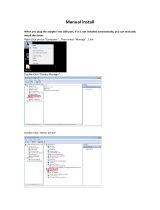
2D-Link DWA-132 User Manual
Table of Contents
Product Overview ......................................................................3
Package Contents .........................................................................3
System Requirements ................................................................. 3
Introduction ...................................................................................4
Features ............................................................................................5
Hardware Overview ..................................................................... 6
Installation ..................................................................................7
Getting Started ..............................................................................7
Remove Existing Installations .......................................... 7
Disable Other Wireless Adapters .....................................8
Wireless Installation Considerations ....................................10
Adapter Installation ...................................................................11
Wi-Fi Protected Setup (WPS) ..........................................14
Connect to a Wireless Network ............................................ 17
Using Windows
®
7 .......................................................................17
Connect to a Wireless Network ............................................ 18
Using Windows Vista
® ..................................................................................................................18
Using Windows
®
XP ....................................................................19
Wireless Security ..................................................................... 20
What is WPA? ................................................................................20
Using Windows
®
7 ...............................................................21
Using Windows Vista
® .....................................................................................................24
Using the Windows
®
XP Utility ........................................26
Troubleshooting ..................................................................... 28
Wireless Basics ........................................................................ 32
Wireless Modes ............................................................................36
Networking Basics .................................................................. 37
Check your IP address ...............................................................37
Windows
®
XP Users .............................................................37
Windows
®
7/Windows Vista
®
Users ................................37
Statically Assign an IP address ...............................................38
Windows
®
XP Users .............................................................38
Windows
®
7/Windows Vista
®
Users ................................39
Technical Specications ........................................................ 40
Table of Contents





















